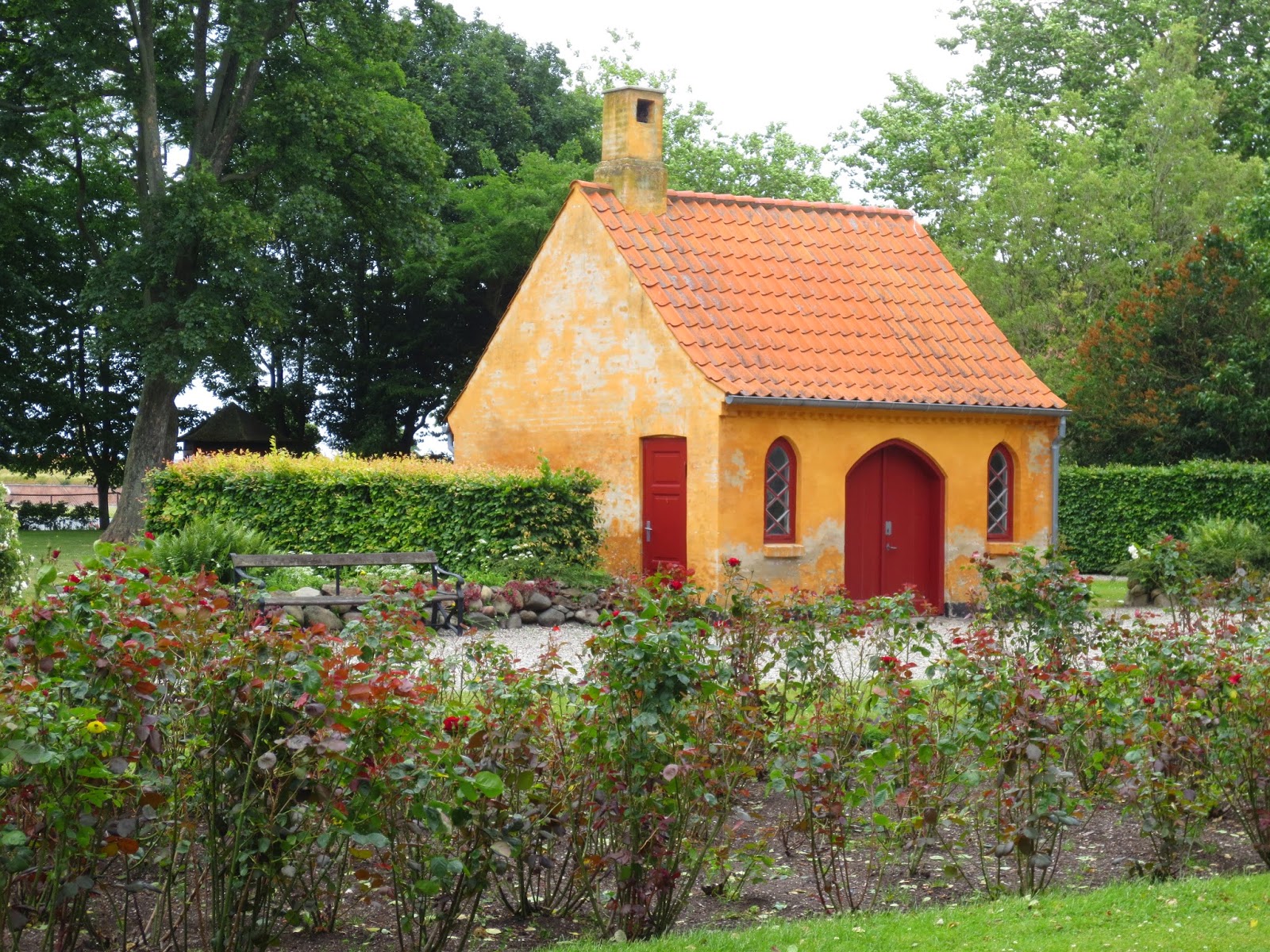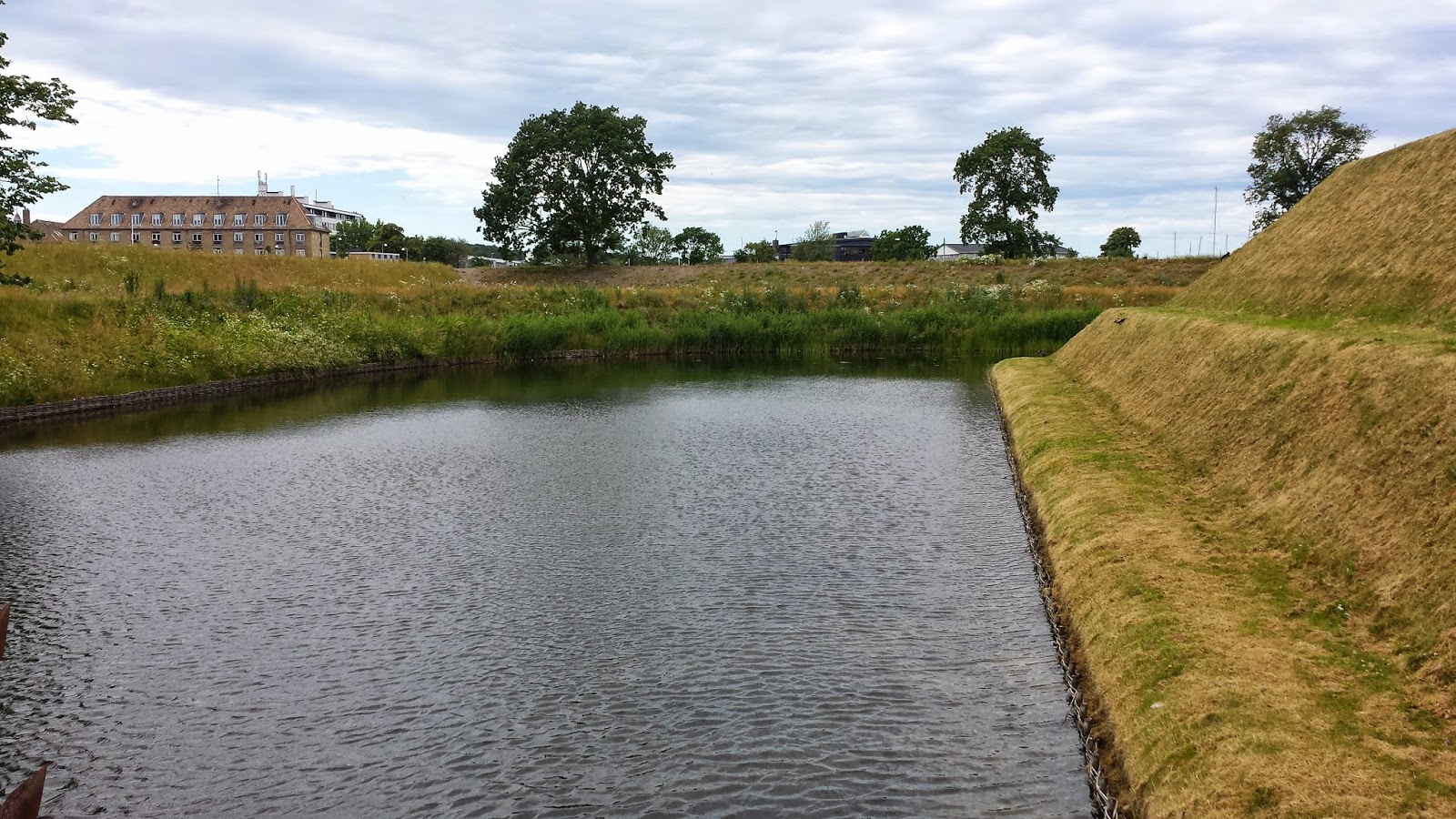Aside from the woman at the counter, this was what greeted me when I first arrived at my hotel in Helsingor. It's a picture of British actor Derek Jacobi playing Hamlet, and this scene is a famous one where he finds the skull of Yorrick, the king's jester in the old days, and meditates rather gloomily on how no matter how great you might have been in life, you will still end up in a grave one day.
After dropping off my bags, I headed to this restaurant, which dates back to the 1600s and has two British Royal Navy cannonballs lodged in the cellar back from when Lord Nelson was going around making sure there was no fleet left in Denmark to help Napoleon. The sandwich I had there was a little disappointing after the fare I've eaten in Copenhagen, but the atmosphere and lower price of the food made up for it.
This town has retained a great deal of its historical character, some of it dating all the way back to the medieval period, so even though it was raining on and off all afternoon (mostly on), I thoroughly enjoyed walking up and down its charming roads.
Apparently things close up early on Saturdays, though, because all the shops were done for business by the time I finished lunch, which was about 3:00 in the afternoon. The liquor store across from my hotel remains open, as do many cafes and bars, in order to accommodate all the Swedes who ride the 20-minute ferry over from Helsingborg to drink. Apparently there's quite a stiff tax on alcohol in Sweden, so they pop over here to indulge.
My favorite part of the afternoon was discovering this beautiful location, which was established as a convent in the 1400s, then became a hospital for the old and infirm after the Reformation. I was lucky enough to have the place to myself as I explored, and after all the busyness and stimulus of the past week, it was a very welcome respite of peace and quiet.
There's always something profound about running your hands over bricks and mortar that were touched by hands over 500 years ago. Sitting in one of the arches and listening to the breeze blowing through the massive tree in the center made me see some of the appeal of life in a convent. Especially one as lovely as this one. The video below is sideways, unfortunately (the only way to capture the whole tree was to turn my camera), but enjoy a few peaceful moments yourself:
This is what it looked like upstairs:
And this charming little building was out back.
Beyond the cottage is another stretch of grass, and then there's the sea. You can hear the call of seagulls from all over town and smell the salty tang of the water.
This morning, I attended church at St. Olaf, which is absolutely gorgeous inside, but which I cannot share because photos are not allowed even when there isn't a service going on. Even though I don't speak Danish, I still enjoyed all the hymns (though the congregation seems to be made up of about 25 senior citizens, there is still an organ and full choir singing) and recognized from a few key words when they were reciting the Apostle's Creed. I also got to see the baptism of two babies. Church is church wherever you go, which I find both beautiful and reassuring.
After that, I spent a good four hours exploring the famous Kronborg Castle, including a relaxed lunch at the café with another London couple and an American woman from New York. I saw them recognize each other from the train, and when the American asked if she could join them, I sort of jumped in as a kind of double-crasher to the party, and it turned out to be great fun.
Anyway, back to the castle/fortress, which in the medieval period was a simple square structure (called "Krogen") that was mostly just walls and a couple smallish dwelling places. Then Frederik II came along and built most of what is now Kronborg, with additions and embellishments added in later years by (you guessed it) Christian IV (Frederik's son). The weather varied today between brilliant sunshine and rain, appropriately changeable and moody, I suppose. There's not just one but two moats, and crossing over the second one, I happened upon a little family of swans.
It's hard to get a sense of just how massive this structure is without being there in person, but this should give you an idea. Take note of how many windows there are, which (because of how expensive glass was in those days) was another way for Frederik to flaunt his wealth.
The large majority of construction was funded by something called the "Sound Dues," which was a toll system established by Erik of Pomerania in the 1400s. What Kronborg (and earlier Krogen) overlooked is this:
This strip of water, known as "The Hook," separates Denmark on this side, and Sweden on the other ("I can see Sweden!"). Only for centuries, Sweden was actually part of Denmark, and because he had sovereignty over the land on both sides of this stretch of water--which was the only passage from the Baltic Sea (basically anything coming to or from the Middle East) to the rest of the world--Erik realized he could make a fortune by charging all the ships a fee to go through. When a ship came by, it was supposed to lower its flag halfway to show it was coming into port to pay the toll. If it didn't, then a warning cannon was fired off, and the non-compliant ship would then have to pay both the toll and the cost of the cannon ball.
When a fire destroyed the entire interior of the castle, Christian IV simply doubled the toll to fund the rebuilding. This system not only made Denmark a lot of money, but the kings and queens who lived here also benefitted from having first dibs on buying whatever luxurious and exotic goods were passing through on the ships.
Because of the fire and because of the castle's function as a military barracks for decades in the late 19th and early 20th century, the interior doesn't look very much like it did originally (or even as it did after the fire) and the plain white walls and ceilings (and floors) would have been much more heavily decorated. The black and white marble floors and the tapestries are some of the few remaining authentic details that are actually from Kronborg. Many of the other items were brought in from other locations, though they replicate or match the types of art/furnishings of Christian IV's period, so I'm not really going to bother putting up photos of those rooms (trust me, you're not missing anything). What I will put up are photos of one of the surviving tapestries and photos from the chapel, which was the only part of the castle untouched by the fire. The elaborate panels, colors, and detailing is what we were told the rest of the castle would have had as well. Interestingly enough, this chapel was the first constructed specifically as a Reformed chapel and not a Catholic one.
(this shot came out a bit blurry because of the low light--this is the ceiling paneling)
Again, very dark and heavy (like Rosenborg Castle's interior) but beautiful. The real "wow factor" (Frederik might not have had the term, but he understood the concept) is this ballroom, which was the largest one in Europe at the time. Frederik wanted to impress everyone visiting with Denmark's wealth and power, and this must have done the trick because it was famous all over Europe. No one knows for sure if Shakespeare actually ever visited this castle himself, but it is possible since English and Scottish actors ("players") were brought in to perform for royalty, and King James of England (the same one who sponsored Shakespeare's acting troupe) once stayed at Kronborg with his Danish wife for four months. Either way, Shakespeare would have been familiar with the grandeur of this castle, and since this was a hub of commerce at the time, it seemed a natural fit to be the setting for Hamlet.
Above is a shot when it was empty in the afternoon and below is a shot of it filled with some sort of military event that was going on in the morning when I first arrived, which also gives a sense of its massive scale.
And this is the Queen's Gallery/passage, which Frederik had built for his wife Sophie so she could get to both the chapel and the ballroom without having to cross the cold, wet courtyard (her chambers were separate from Frederik's, as was the custom of the day).
Our modern sensibilities might be somewhat creeped out by the fact that he was 38 and she was only 14 (and they were cousins) when they first met, but a number of sources seem to indicate that they were genuinely in love and had a great affection for each other, which was something of a rarity in royal marriages of that time.
Some random pictures of doors, because I am slightly obsessed with old doors:
Guess who had the door above ordered? That's right--as always, he left is trademark "C" with the "4" embedded right under the knocker.
A super cool passageway
and a parting shot of the castle when the sun was blazing (the streak of light being some freakish--but neat--accident of my camera)
Now I am off for some dinner and am hoping I can find someplace to eat other than my hotel, which is ridiculously overpriced. There are hardly any people here in town now--it's really more of a ghost town--as most of the tourists get back onto buses or the train to go elsewhere after a few hours here, and no one's coming over from Sweden to drink and party on a Sunday evening. It's borderline eerie how quiet it is here, but it's also kind of a nice change. Tomorrow I'm back on the train and headed south to Odense.






































So do they ever put on performances of Hamlet there at Klonborg? It would certainly add some atmosphere/verisimilitude.
ReplyDeleteyes, they do, Bob. Sadly for me, though, performances aren't until August.
DeleteNow you have another excuse to go back.
Deletegood point! :)
DeleteYour pictures are so beautiful. Each one is more amazing than the last. Also, everything is so old! If something is 40 years old here, we are amazed.
ReplyDeleteEllen